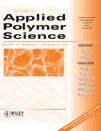Preparation of microcapsules containing TMBA (1,3,5-trimethylbarbituric acid) by the drying-in-liquid method and its application
Abstract
1,3,5-trimethylbarbituric acid (TMBA), an amphiphilic material used widely for redox catalysts, such as organic peroxide, aromatic tertiary amine, and anhydride, was microencapsulated by the drying-in-liquid method with polyethylene methacrylate (PEMA) as a wall material. To prevent osmotically induced leakage of the core material into the continuous water phase during the microencapsulation process, TMBA was beforehand dissolved into the continuous water phase. In the experiment, the amount of TMBA dissolved and holdup of the dispersed oil phase were changed. The microencapsulation efficiency increased with the increase in the amount of TMBA dissolved but remained 36% at the highest even with the saturated level of TMBA. Also, the microencapsulation efficiency decreased with increase in holdup. The microcapsules containing TMBA were used for preparing a biological hard tissue-adhesive material and estimated for the microencapsulation effects. The adhesives containing the microencapsules were found to have excellent bonding properties and high storage stability. © 2008 Wiley Periodicals, Inc. J Appl Polym Sci, 2008




